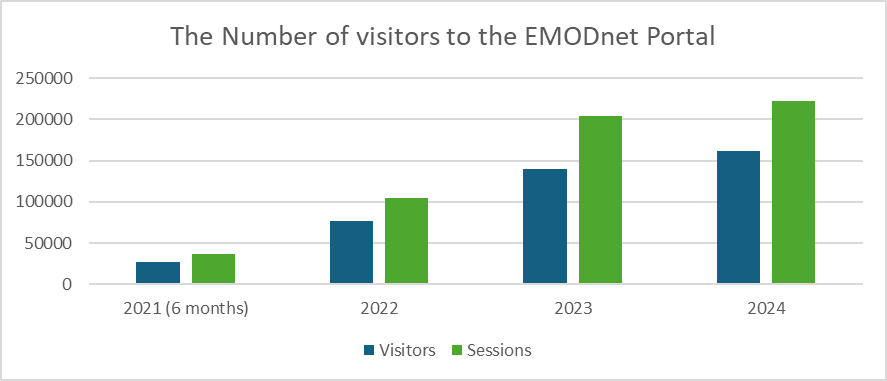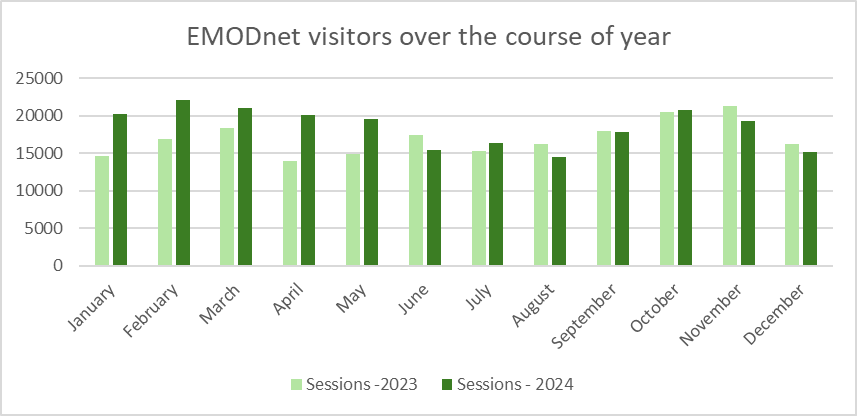Introduction by Conor Delaney, EMODnet Technical Coordinator
Just over two years ago, in January 2023, EMODnet took a bold step by transforming from seven distinct Thematic Portals—covering Bathymetry, Biology, Chemistry, Geology, Human Activities, Physics, and Seabed Habitats—into a single, unified web portal. Spearheaded by the EMODnet Central Portal Technical Team and thematic coordinators, this transition consolidated marine data access, simplifying user experience and enhancing efficiency. Today, that decision is paying off, with more users than ever accessing critical marine data through the streamlined EMODnet Portal..The EMODnet portal is an operational service of DG Mare that is continuously updated to ensure that it provides reliable and fast access to European scale marine data products over the seven thematic areas. Centralisation is part of a strategy to simply and amplify accessibility to EMODnet products.
So, after two years of centralised EMODnet how are we doing?
Brief overview of EMODnet web visitor trends
Centralization was more than just a technical upgrade—it transformed how users access marine data. In 2023 alone, the unified portal welcomed 30% more visitors than all previous thematic sites combined. Capturing metrics of visitors to the EMODnet Portal is an important indicator of usefulness of the Portal, the logic being that we will only have visitors if the Portal is useful. Figure 1 illustrates the before and after of the centralisation of the EMODnet thematic portals. The years 2021 and 2022 cover the period before centralisation, when the EMODnet central moved to Europa.eu domain to become an official service of the European Commission (EC). In January 2023 the seven thematic portals were unified with the Central portal, shut down and started to redirect traffic going to their old sites to the new EMODnet Portal.

Figure 1: Statistics for 2021 and 2022 are for the central EMODnet Portal. From 2023 all other EMODnet Portals were unified with the central portal and shut down. Visitors = unique visitors. Sessions = repeat visitors and people spending time on the site
In Figure 1, we observe a significant increase in visitors to EMODnet following its centralization, with the portal now more popular than ever.
The yearly pattern in EMODnet visitor numbers
In Figure 2 we have a side-by-side comparison of monthly EMODnet visitor numbers (sessions in this case) for the years 2023 and 2024. This type of analysis is useful because it provides an insight into what can be expected in terms of usage of the EMODnet over the course of a typical year. For example, looking at the graph in Figure 2, it can be determined that most activity on the EMODnet portal happens in the Spring and the Autumn, with a decline in the Winter and the Summer. The caveat here is that we are only at two years of data, so it will be interesting to see how this analysis develops in the future.

Figure 2: A side-by-side, comparison of EMODnet web statistics for the years 2023 and 2024.
What to expect for 2025
The development of the EMODnet Portal and its network of data catalogues is an ongoing process, driven by user feedback and insights from monitoring usage statistics. Metadata—the essential information that describes datasets, making them FAIR (Findable, Accessible, Interoperable, and Reusable)—plays a crucial role in ensuring that EMODnet’s vast marine data resources remain easily discoverable and useful.
For 2025, the focus will be on enhancing metadata quality and refining the interface of the EMODnet Catalogue to facilitate better access to and reuse of data products. Key improvements planned for the year include:
- Enhanced Metadata Consistency: Standardizing metadata across all EMODnet thematic data services to ensure uniformity and better data discoverability.
- EMODnet Catalogue Upgrade: Implementing the latest Open Source GeoNetwork technology to enhance the catalogue’s visual interface, dataset tagging, and search functionality, making it easier for users to locate relevant data.
- Improved Accessibility in the EMODnet MapViewer: Enhancing accessibility for visually impaired users by improving keyboard navigation, optimizing the colour palette for better contrast, and implementing screen-reader-friendly tagging of controls.
These enhancements will strengthen EMODnet’s role as a leading open-access marine data platform, ensuring that its resources are not only high-quality but also intuitively searchable and accessible to a diverse range of users.
Curious about the new features? Explore the EMODnet portal today and discover how easy accessing marine data can be!
